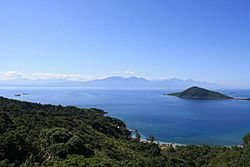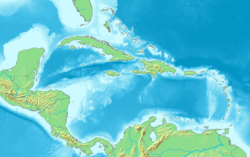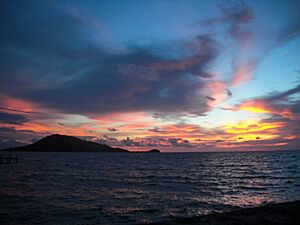Cayos Cochinos facts for kids
|
Nickname: Hog Islands
|
|
|---|---|

View from lighthouse facing southwest
|
|
| Geography | |
| Location | Caribbean Sea |
| Coordinates | 15°58′18.99″N 86°28′31.34″W / 15.9719417°N 86.4753722°W |
| Archipelago | Bay Islands |
| Total islands | 15 |
| Major islands | 2 |
| Area | 2 km2 (0.77 sq mi) |
| Administration | |
| Department | Bay Islands |
| Municipality | Islas de la Bahía |
| Demographics | |
| Population | 108 |
| Pop. density | 54 /km2 (140 /sq mi) |
| Ethnic groups | Garifuna |
The Cayos Cochinos are a group of beautiful islands and coral reefs off the coast of Honduras. Their name means "Hog Islands." There are two main islands, Cayo Menor and Cayo Grande. Plus, there are 13 smaller coral islands called cays.
These islands are about 30 kilometers (19 miles) northeast of La Ceiba. Even though they are separate, they are part of the Bay Islands area. They also belong to the Roatán municipality. In 2001, about 108 people lived on the islands. The total land area is small, only about 2 square kilometers (0.77 sq mi).
The waters around Cayos Cochinos are a special Marine Protected Area. This means they are kept safe by the Honduras Coral Reef Foundation. The coral reefs here are part of the huge Mesoamerican Barrier Reef System. This is the second largest coral reef system in the world! On Cayo Menor, there is a science station. Scientists study the amazing ocean life there.
National Geographic magazine has said that these waters are like a dream for marine biologists. They are protected by the government. Commercial fishing and diving are not allowed. This helps many sea creatures, some of which might not even have names yet, to thrive.
Contents
Exploring the Cayos Cochinos
The Cayos Cochinos are very natural. You won't find any roads, cars, or bikes here. On Cayo Grande, there is a walking path. It connects homes and beaches.
You can hike to a lighthouse on the highest point of the island. The path goes through beautiful jungles. These jungles are home to a very special animal: the only pink boa snakes in the world!
The islands have a few residents. There are Garifuna fishing villages called Chachahuete and East End. There are also nine private homes on Cayo Grande. Six more homes are on the 13 smaller cays. You can reach the islands by boat from La Ceiba. You can also take a sailboat from Utila or Roatán.
Protecting the Ocean Life
The efforts to protect the underwater world have made the Cayos Cochinos waters very healthy. They have some of the best marine life in the Bay Islands. The Honduras Coral Reef Fund works hard to keep the rules for the marine park. They also collect a small fee from visitors. This fee helps them protect the area.
If you are a backpacker, you can find cheap places to stay. The Garifuna villages of East End and Chachahuete offer hammocks or simple huts.
Getting to Cayos Cochinos
You can get to Cayos Cochinos from Roatán by booking a special boat trip. Smaller boats also leave from La Ceiba, Sambo Creek, and Nueva Armenia. Dive shops in Utila also offer trips.
There are daily trips from La Ceiba. Companies like Cayos Cochinos Divers and Pirate Islands Divers offer scuba diving trips. You can go for a day or even stay overnight.
Saving the Natural Beauty
The Cayos Cochinos are a very important part of the Mesoamerican Barrier Reef System. In 1994, the islands and their surrounding waters became a marine reserve. This was done with help from the Smithsonian Institution. The goal was to protect all the plants and animals in the area. The reserve covers about 460 square kilometers (178 sq mi). It stretches eight kilometers (5 miles) in every direction.
Laws in the reserve stop all commercial fishing. This means no big fishing boats, nets, or traps. However, local Garifuna people are allowed to fish with hand lines. They cannot use nets or spears. In some special areas, there is a lobster diving season for qualified Garifuna fishermen.
Since 1994, many groups have helped protect this beautiful area. These include the Smithsonian Institution, World Wildlife Fund (WWF), Honduras Coral Reef Fund, and Operation Wallacea.
See also
 In Spanish: Cayos Cochinos para niños
In Spanish: Cayos Cochinos para niños




